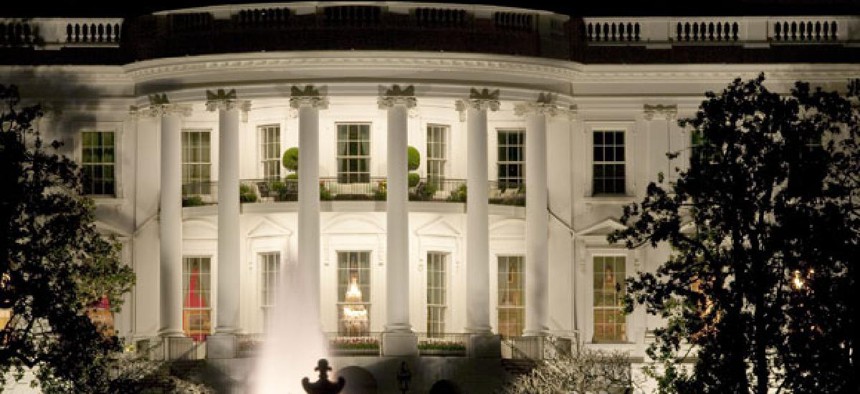
The White House has wrapped its kill list in secrecy and already the United States has killed four Americans in drone strikes. MISHELLA/Shutterstock.com
How Many Americans Are on the Kill List? Zero.
The Obama administration has asserted it has legal authority to kill U.S. citizens who join al-Qaida.
No Americans are currently marked for death on the U.S. government’s terrorist strike list, according to the chairman of the House Intelligence Committee.
The White House has wrapped its kill list in secrecy and already the United States has killed four Americans in drone strikes. Only one of them, senior al-Qaida operative Anwar al-Awlaki, was the intended target, according to U.S. officials. The others—including Awlaki’s teenage son—were collateral damage, killed because they were too near a person being targeted.
But no more Americans are in line for such killings—at least not yet. “There is no list where Americans are on the list,” House Intelligence Chairman Mike Rogers told National Journal. Still, he suggested, that could change.
The Obama administration has asserted it has legal authority to kill U.S. citizens who join al-Qaida, so long as the individuals rise to a leadership position in the group and plan attacks against the nation. That rationale has driven many lawmakers to join civil-rights groups’ long call for the White House to open up about the strike list, the criteria, and its counterterrorism policy more broadly.
At its height, the demand by Sen. Rand Paul, R-Ky., that the administration publicly state it does not have the right to ignore the Constitution’s guarantee of due process by killing an American on U.S. soil led to a 13-hour filibuster of CIA Director John Brennan’s nomination. It garnered so much attention and support that more than a dozen Republican senators joined Paul on the Senate floor and won acaveated concession from Attorney General Eric Holder that the U.S. would not use drones to take out Americans who were not actively engaged in combat.
The White House will not talk about the strike list. It would not comment on Rogers’s statement that no Americans are currently being targeted. But the lawmaker’s assertion fits with what’s known about the American terrorists who most worry the federal government.
Four U.S.-born men are listed on the FBI’s Most Wanted Terrorists list: Adam Gadahn, Omar Hammami, Jehad Serwan Mostafa, and Abdul Yasin. They also are highlighted in the National Counterterrorism Center’s macabre 2013 calendar, which provides descriptions of terrorist groups, wanted men, and terrorist threats in a daily-planner format.
But, according to what officials have released about the criteria the U.S. government uses, a potential target must be a senior, operational leader of al-Qaida or an affiliated group who presents an imminent threat of violent attack against the United States. These four men do not appear to fit the bill. While Gadahn, perhaps the best known of the group, rose quickly in al-Qaida’s ranks, he serves as a propagandist, not an operational planner.
“Some notion that every American would even rise to the list by just going over and even signing up is, candidly, just not the truth,” Rogers said.
Awlaki, Rogers said, was unique among homegrown terrorists—he publicly declared jihad against the United States, and he was involved in multiple terrorist-related plans, including the failed Christmas Day bombing and the Fort Hood shooting.
“What worries me is they are taking this isolated case and saying, ‘Oh well, there’s a list of Americans, and you could be on the list of Americans.’ That just simply is not how this works,” he said.
But Rogers, who said he reviews every strike after it is carried out and sends his staff to a monthly meeting with intelligence officials to ensure staffers have enough information on the strike program, cautioned that should another American citizen again attain the status Awlaki did, the U.S. government has the authority to kill him.
“If you ever got another American who rose to that same level in the ranks and leadership role in al-Qaida and they were operating in Yemen or Mali or southern Algeria or Libya, well, they’ve picked their team, and their team is al-Qaida. And the United States is in conflict with al-Qaida. In the rules of war, you’re allowed to defend yourself.”
The question of American citizens being on the kill list is just one of many concerns raised about U.S. counterterrorism strategy and drone strikes. Among them, civil-rights groups, security experts, and lawmakers question the administration’s legal authorization for the strikes, the lack of third-party review, the opacity of the policy, and the potential blowback the United States faces over collateral damage.
“If your focus is on the handful of Americans who have been killed, and only one of them was killed intentionally, you’re really missing the bigger story,” said Micah Zenko, national security expert at the Council on Foreign Relations.
Senate Intelligence Committee member Angus King, the Maine independent who has called for greater oversight of the drone program, said he thought the administration was taking calls for greater transparency seriously.
“There’s a possibility of reasonable people finding a solution here. And to me, the important thing is not necessarily the representations of the administration or all the things they’re putting in place,” King said. “The problem is, you can’t rely on that five, 10, or 15 years from now. You’ve got to have a structure in place that will protect us.”
(Image via MISHELLA/Shutterstock.com)






